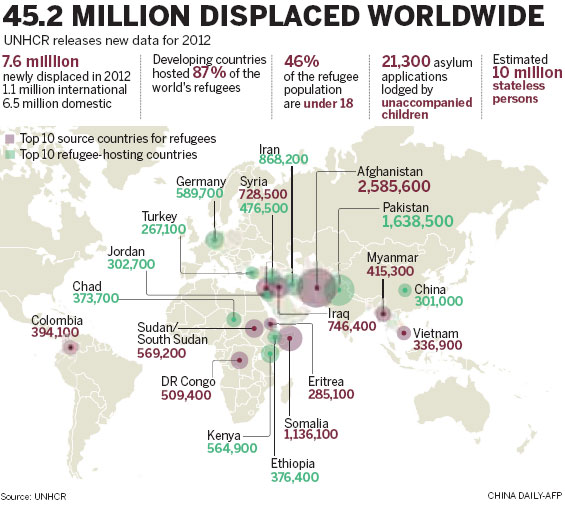Refugee children made welcome in Hebei schools


Four foreign refugee children have become the first to attend Chinese public schools, marking a symbolic achievement in China's refugee relief work.
In an interview with China Daily ahead of World Refugee Day on Thursday, Giuseppe de Vincentiis, regional representative of the United Nations High Commissioner for Refugees, said his team received great support from China's central government and local education authorities when they placed the children in schools.
Three schools in Hebei province offered special protection for the children by hiding their refugee status. When the children started school in May, teachers asked their classmates not to treat the new students any differently so they could assimilate.
It is an important breakthrough for China to offer education opportunities to foreign refugees because it shows China's willingness to shoulder more responsibilities, said Pang Zhongying, a professor of international affairs at the Renmin University of China.
De Vincentiis praised the progress China has made to implement the 1951 Refugee Convention, one of the key legal documents in identifying refugees, their rights and the legal obligations of states.
In 2012, China enacted an Exit-Entry Administration Law, which will take effect on July 1 and allow asylum-seekers to use a temporary ID card to stay in the country while their refugee status is under examination.
It also allows refugees to stay in China after obtaining an ID card from public security authorities.
The provision is extremely important because during that period of examination, it lets refugees stay as legal residents rather than illegal foreigners due to incomplete required documents, De Vincentiis said.
The representative saw this law as a "positive step" for China in the implementation of the 1951 convention because it indicates "the willingness and determination of the Chinese government" to enact a more comprehensive system for providing asylum.
Besides the convention, China also participates in another international refugee pact, the 1967 Protocol. However, legislative law states that international protocols are only enforced if they are written into domestic law.
"It is only the beginning, and the protocol needs to be translated into specific regulatory acts," said the representative.
In recent years, the attention that the public pays to refugee issues keeps growing as academia gets more involved, and more students volunteer to work on refugee-related projects in China, said De Vincentiis.
When asked about issues while working in China, the representative preferred not to use the word "difficulties" because the agency has had good experiences with the country and has strengthened cooperation over the past 30 years.
The agency opened its Beijing office in 1980 and helped resettle about 300,000 refugees who fled to China following the Sino-Vietnamese border conflicts in the late 1970s.
These refugees and their children have remained in the country and are considered to be integrated into Chinese society.
Meanwhile, a report released by the UN High Commissioner for Refugees on Wednesday said the number of refugees in China has remained largely unchanged since the early 1980s with 301,000 in total, making the country the ninth-largest refugee-hosting country.
According to the annual report, little changed last year in the rankings of major refugee-hosting countries. Pakistan continued to host more refugees than any other nation with 1.6 million, followed by Iran with 868,200 and Germany with 589,700.
With the emergence of the crisis in Syria as a major new factor in global displacement, the report showed that more people are refugees or have been internally displaced than at any time since 1994.
The report shows that more than 45.2 million people were displaced at the end of 2012 compared with 42.5 million at the end of 2011. This includes 15.4 million refugees, 937,000 asylum seekers and 28.8 million people forced to flee within the borders of their own countries.
Fifty-five percent of all refugees listed in the report come from just five war-affected countries, namely Afghanistan, Somalia, Iraq, Syria and Sudan, making war remain as the dominant cause of refugees.
The report also charts major new displacement from Mali, in the Democratic Republic of the Congo, and from Sudan into South Sudan and Ethiopia.
Zhang Fan contributed to this story.
zhouwa@chinadaily.com.cn

(China Daily 06/20/2013 page10)












